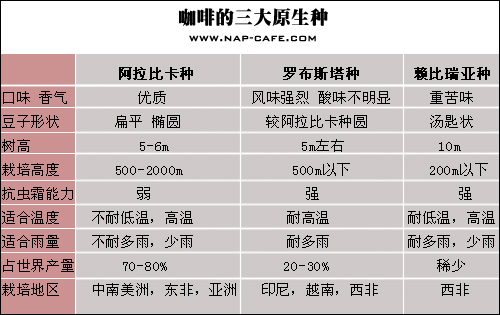The three native species of high-quality coffee
There are three main varieties of coffee: Arabica Arabica, Robusta Robusta, and Liberia Liberica. The first two are relatively long-term, while the latter is hardly in circulation on the market and is only traded within parts of West African countries.

Arabica is mainly produced in Brazil, Colombia, Guatemala, Jamaica, Mexico and other American countries, Costa Rica in the Caribbean, Ethiopia and other countries.
?
It is difficult to grow, they prefer mild days and cooler nights, grow luxuriantly in highlands (1800 m), and require special climatic conditions-a year-round temperature of about 38 degrees and abundant precipitation. A tropical mountain climate that does not defrost. Only more than 50 countries in the world have such conditions, all of which are about 160 kilometers north and south of the equator.
?
However, due to the excellent aroma, balanced taste and low caffeine content of Arabica, the actual planting amount accounts for 70-80% of the total coffee planting. The familiar Santos of Brazil, Manning of Sumatra, Moka of Yemen and Blue Mountain of Jamaica all belong to the high-quality coffee beans of Arabica.
?
Robusta is mainly produced in Uganda, Ivory Coast, Congo, Angola and other countries. Coffee beans are small and of different shapes, but Robusta coffee trees are resistant to high temperature, cold, humidity, drought and even bacterial invasion; they are so adaptable that they can grow well on flat land and do not need to be harvested manually.
?
However, Robusta has poor aroma, strong bitterness, insufficient acidity and high caffeine content, so it is usually used for blending or instant coffee.
Liberica is native to West Africa and has strong adaptability to various environments, but it is not resistant to leaf scab and its flavor is worse than that of Arabica.
Important Notice :
前街咖啡 FrontStreet Coffee has moved to new addredd:
FrontStreet Coffee Address: 315,Donghua East Road,GuangZhou
Tel:020 38364473
- Prev

How to judge the quality of coffee beans by boutique coffee technology
Judgment of appearance: delicious coffee can be known from the shape of its roasted coffee beans, of course, there can be no bad coffee beans mixed with, what is more important is that normal beans will also be mixed into high-quality coffee beans and cause hindrance. A fried roasted bean that brews delicious coffee must first be big, fat and uniform, and secondly, it is uniform in size without color spots. These are the main points of visual discrimination, such as
- Next

Basic Cognition of Coffee trees
The origin of the coffee tree is Ethiopia in Africa. In botany, coffee trees belong to the long green trees of the subgenus Rubiaceae, and coffee beans, commonly known as coffee beans, are actually the seeds of the fruit of coffee trees, just because they are shaped like beans, so they are called coffee beans. Climate is the decisive factor for coffee cultivation. Coffee trees are only suitable for growing in the tropics or subtropics, so latitude 25 is south and north.
Related
- Beginners will see the "Coffee pull flower" guide!
- What is the difference between ice blog purified milk and ordinary milk coffee?
- Why is the Philippines the largest producer of crops in Liberia?
- For coffee extraction, should the fine powder be retained?
- How does extracted espresso fill pressed powder? How much strength does it take to press the powder?
- How to make jasmine cold extract coffee? Is the jasmine + latte good?
- Will this little toy really make the coffee taste better? How does Lily Drip affect coffee extraction?
- Will the action of slapping the filter cup also affect coffee extraction?
- What's the difference between powder-to-water ratio and powder-to-liquid ratio?
- What is the Ethiopian local species? What does it have to do with Heirloom native species?

